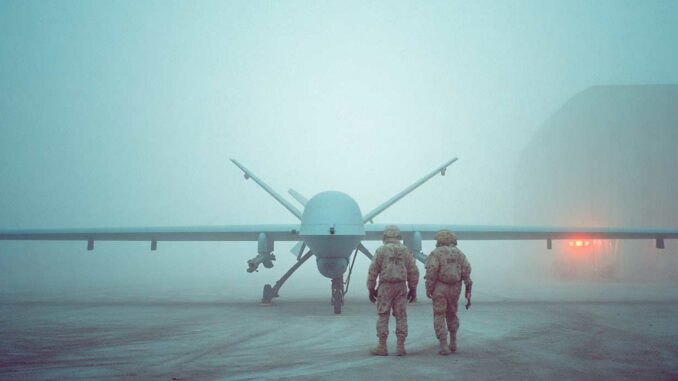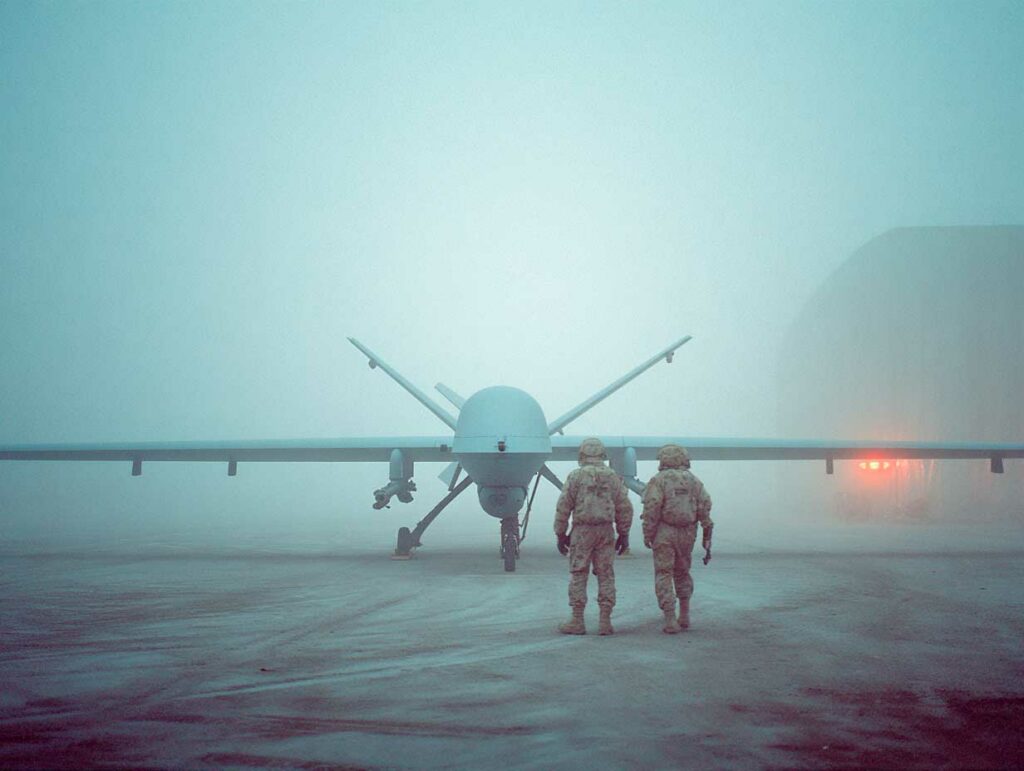
The US Army is considering replacing its heavy brigades in Europe with expeditionary drone units, which are more mobile and less expensive.
Summary
For nearly eight decades, the structure of the US Army has been based on the presence of heavy mechanized brigades designed to defend Europe. But with Washington redefining its strategic priorities, some experts, including Benjamin Jensen of the Center for Strategic and International Studies (CSIS), are suggesting a radically different model: replacing some of these forces with expeditionary drone units. These battalions, composed of approximately 250 soldiers and 500 drones, could be deployed more quickly, operate alongside European forces, and limit logistical costs. The concept, based on technological substitution, challenges the traditional doctrine of deterrence and paves the way for a more flexible army, adapted to the technological wars of the 21st century.
The strategic context of the US Army and Europe
Since the end of World War II, the United States has designed its army around the defense of the European theater. During the Cold War, tens of thousands of soldiers were stationed in Germany, Italy, and Great Britain to contain the Soviet Union. This structure resulted in a heavy model: armored divisions, artillery, and massive logistics.
Today, the situation has changed. Washington’s priorities are shifting. Under the Obama administration, the pivot to Asia strategy marked a rebalancing toward the Pacific. Subsequent administrations have emphasized homeland security, hemispheric interests, and competition in the Indo-Pacific. In this new framework, Europe is no longer at the heart of U.S. strategy.
This repositioning poses a dilemma: what to do with an army designed for large-scale continental conflict? This is where Benjamin Jensen, director of the CSIS Futures Lab, comes in with a disruptive idea: using drones as a partial substitute for ground forces.
The proposal to replace them with drone units
Jensen proposes reducing the permanent presence of heavy brigades in Europe, which are costly to maintain and difficult to move, in favor of expeditionary drone battalions.
He envisions a unit of 250 soldiers equipped with 500 FPV (First-Person View) drones and multi-role octocopters. These light forces could be deployed quickly from the United States or pre-positioned at European bases to support NATO allies.
The concept is based on an economic analogy: that of substitution. Just as a consumer might replace one product with another equivalent but cheaper one, the military could substitute certain conventional equipment or missions with unmanned systems capable of offering similar operational value at a lower cost.
In this architecture, European countries would continue to provide conventional ground forces—tanks, armored vehicles, infantry—while the United States would provide strike, reconnaissance, and electronic warfare capabilities via its drones. This model would promote responsiveness, reduce heavy logistics, and limit the costs of permanent stationing in Europe.
Technical analysis and key figures
Technically, FPV and octocopter drones offer great modularity. They can be configured for observation, attack, or electronic jamming missions. Their low unit cost—sometimes less than $10,000 for a tactical model—allows for mass production and rapid replaceability.
However, Jensen argues against abandoning medium-altitude, long-endurance (MALE) drones such as the MQ-1C Gray Eagle, which has an endurance of 24 hours and a payload capacity of eight Hellfire missiles. These aircraft can cover large areas and provide permanent air support to ground forces.
Jensen’s calculations are based on a replacement battalion of 250 personnel and 500 drones, compared to 1,000 personnel for a conventional battalion. This 75% reduction in human resources drastically reduces the costs associated with accommodation, transport, and maintenance of heavy equipment.
An American armored brigade deployed in Europe currently represents an estimated annual cost of $2.3 billion in operations and logistical support. In comparison, a drone force of equivalent size would require a significant initial investment but much lower maintenance costs in the long term.
This approach does not eliminate the need for soldiers, but transforms their role: system operators, data analysts, electronic warfare or cybersecurity specialists.
The consequences for NATO and European forces
For NATO, this evolution would imply a profound rebalancing of responsibilities. European countries, notably Poland, Germany, and France, would have to assume a greater presence on the ground, while the United States would focus on technological and command capabilities.
This redistribution would change conventional deterrence: instead of permanently deploying armored brigades, Washington could send modular drone brigades capable of deploying within a few days in the event of a crisis. This change alters the “grammar of deterrence”: the psychological effect no longer relies on the visible mass of troops, but on speed and instant strike capability.
European states would need to adapt their doctrines and invest in secure networks and electronic warfare to support these new capabilities. This requires increased coordination between chains of command, communication systems, and engagement protocols.
Finally, this strategy raises a political question: what does Atlantic solidarity mean if the American presence becomes virtual? For some Eastern allies, particularly the Baltic states, the physical presence of American troops is seen as an irreplaceable guarantee of security.

The limitations and resistance of the model
Despite its conceptual appeal, this approach faces several operational limitations.
Drones remain vulnerable to modern air defense systems. The Ukrainian experience shows that TB-2 Bayraktar drones were largely neutralized by Russian radars and jammers. The proliferation of electronic warfare makes communication between drones and operators more complex and risky.
The hidden costs of this transition are also considerable: data infrastructure, system maintenance, operator training, and cybersecurity. Added to this are the legal and ethical constraints associated with the use of autonomous or semi-autonomous weapons.
Finally, a strategic risk remains: that of weakened deterrence. A visible brigade in an allied country exerts political and symbolic influence that a fleet of drones cannot replicate. European leaders may fear “technological Americanization” that does not compensate for the absence of American soldiers on the ground.
Prospects for change and possible scenarios
Three trajectories are possible.
First scenario: the experimental phase.
The US Army tests the concept through pilot units integrated into existing forces. The results determine the feasibility of the drone-centered model.
Second scenario: gradual substitution.
Some heavy brigades are redeployed outside Europe, replaced by drone forces stationed temporarily or on a rotational basis. European allies strengthen their own ground forces.
Third scenario: complete transformation.
Europe becomes a secondary theater for Washington. Drones form the basis of deterrence, while the United States focuses its efforts on the Indo-Pacific. This scenario assumes greater autonomy for Europeans, but also unprecedented technological coordination.
In all cases, the key will be the US Army’s ability to integrate drones into a multi-domain approach: land, air, cyber, space, and electronics. This is already the mission of structures such as the 2nd Multi-Domain Task Force based in Germany, which combines electronic warfare, long-range missiles, and joint intelligence capabilities.
Implications for defense and innovation
This change reflects a global trend: warfare is becoming technological, connected, and data-driven.
Modern armies are reorganizing around artificial intelligence, electronic warfare, and sensor fusion.
Budgets are adapting: in the United States, the Department of Defense now spends more than $14 billion a year on robotics, autonomy, and military AI.
Industrial partnerships are also intensifying. Companies such as Anduril Industries, Shield AI, and Rheinmetall are developing swarms of autonomous drones and software coordination platforms. These technologies, already tested in the Pacific and the Middle East, could be integrated into US forces stationed in Europe.
Finally, this shift towards drones is redefining the relationship between technology and power. Mobility, flexibility, and digital resilience are replacing physical presence and mass as the foundations of deterrence.
The concept of a leaner, partially robotized army is ushering in an era in which drones are becoming central players in land and air combat. While this development promises efficiency and economy, it also raises questions about the nature of military power in the 21st century: less visible, faster, but perhaps also more fragile.
Sources
– Military Times, “Drones could replace large US Army units in Europe, expert suggests.”
– Center for Strategic and International Studies (CSIS), “Drone Substitutes: Rethinking Landpower for an America First Foreign Policy.”
– Financial Times, report on the Anduril–Rheinmetall partnership.
– U.S. Department of Defense, FY2025 Budget – Section AI, Autonomy & Robotics.
– RAND Corporation, “The Future of U.S. Army Posture in Europe.”
– Defense News, reports on the 2nd Multi-Domain Task Force and the transformation of the U.S. Army.
War Wings Daily is an independant magazine.